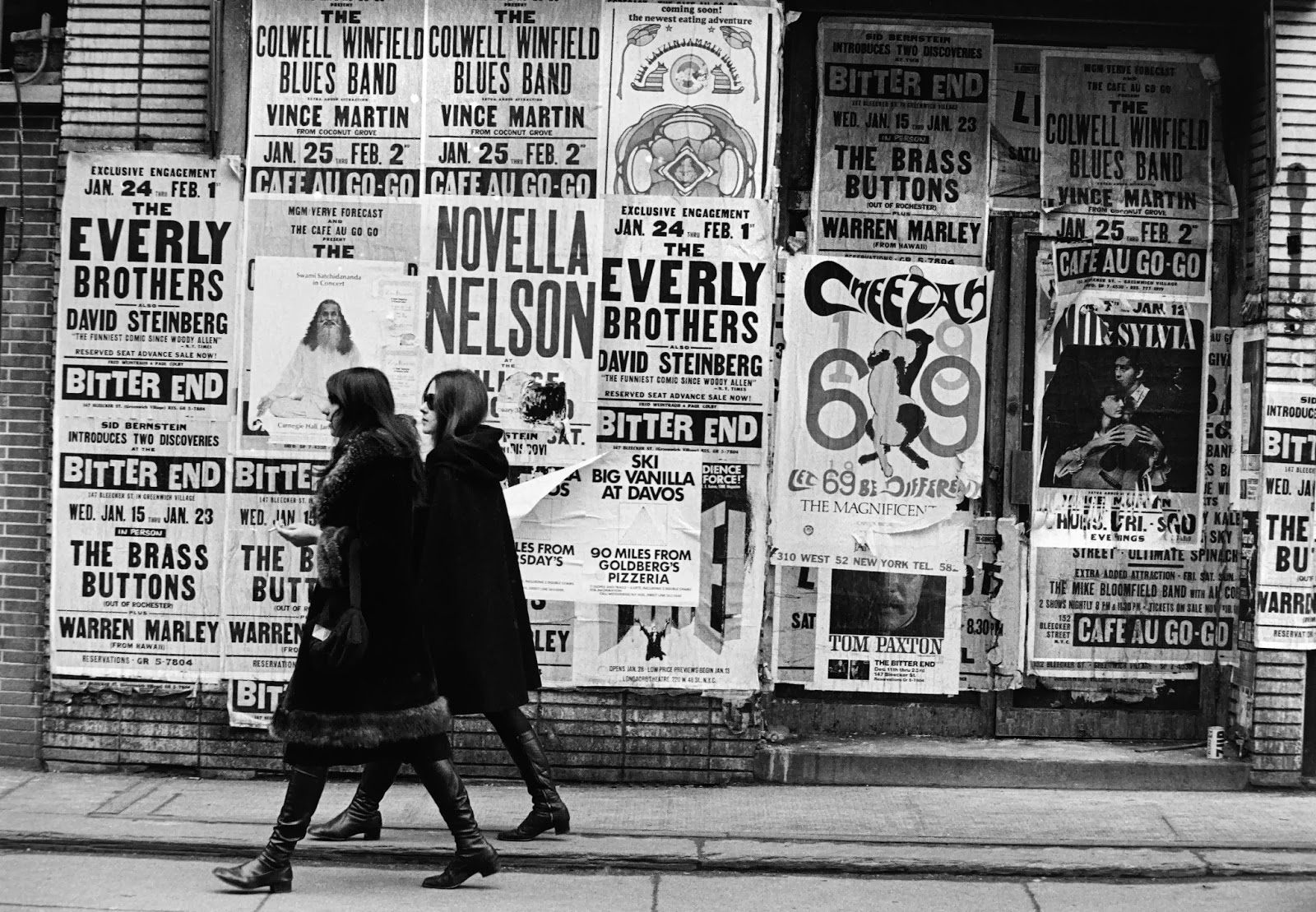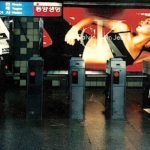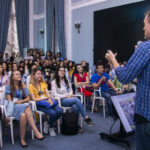(Originally published in Holiday Magazine, December 1965)
One noontime last spring a photographer, two assistants, a lady editor and a fashion model turned up at the corner of Bleecker and Leroy Streets, in Greenwich Village. This is a tenement block and a market district, the nucleus of what is left of the old Bleecker Street community. At this time of day, when Our Lady of Pompei School lets out for lunch, the streets are packed with tough, bright, well-behaved kids whose tumult fills Leroy Street, spilling onto Bleecker. They wear blue blazers with gold-stitched crests on the pockets. The model was dressed in leather, something from one of the fall collections with a wicked, constricting cut to it.
The photographer placed her in the middle of this mob, and while the kids gestured and screamed he took some shots. The model didn’t know exactly what she was supposed to do. The photographer shouted instructions but they never reached her. She assumed something girlish, then something womanly, then settled on a mixture of both, a safe parlay for any fashion story. At first she used the kids as background, striking odd attitudes and making mouths. Then, inspired, she began incorporating the kids, putting her hands on them, looking at them as if they were hers, all 200 of them. I wondered if she had any idea of what some of the older boys were thinking.
But the light wasn’t good, the colors all wrong, the background too busy, the whole idea absurd even for a fashion shot, and the photographer moved her across the street to the markets. The pushcarts there were a natural, but he gave them a pass, posing her in front of a butcher shop whose window featured four freshly slaughtered sheep hanging by their hind legs.
I wondered what these people thought they were doing down here. Obviously, the word had gotten to their editors that Bleecker Street was Fun, Chic and Charming. I doubt that the butcher shop shots made the fashion pages; glamour with grue is too medieval for most tastes. The interesting thing was that the shopkeepers and pushcart vendors barely glanced at the scene. Bleecker has already seen too much of the bizarre.
You can choke on your nostalgia. New York changes—even Bleecker, the Village’s quick artery, changes. Five years ago you could feel the presence of ghosts along the street. Nobody ever claimed to have seen them, but you knew they were around. Poe, for one. And Thomas Paine. Maxwell Bodenheim and Joe Gould, inspired panhandlers working opposite sides of the street. Aaron Burr and Edna Millay; Stephen Crane and Doris the Dupe; Wouter Van Twiller, who set the pattern for 300 years of civic corruption; O’Neill and Barrymore and John Reed and Randolph Bourne—that whole Village crowd. Even an occasional brave of the Sappokanikee, who were here first; before the Dutch, the English, the Irish, the Italians; before the suburbanites of the 1800’s, who moved here from lower Manhattan to escape epidemic, or the proto-Bohemians and anarchists of the early 1900’s, or the all-but-vanished Hippies of the late 1940’s; before the precious Adorables of today’s coffeehouse society.
The street now is hard, commercial, carny. The house where Thomas Paine once lived, between Sixth and Seventh Avenues, is gone. In its place is a supermarket, but this is a block without much interest in history. It is enough that the pushcarts have been allowed to stay, although they were seriously threatened by a City Planning Commission that declared them a traffic obstruction. It was a matter of nine pushcart owners against the commission, and the pushcarts won, with the help of thousands of Villagers. There have been some fine battles fought down here—delaying, containing actions against tunnel-visioned city planners, a stunning series of victories and reprieves. And if stretches of Bleecker have become a graveyard of taste, it has been through popular action—enterprise. Regret for the past is a pariah emotion in New York. You might as well complain that Minetta Brook, which ran into Bleecker once, has been fished out and filled in.
Almost everything that happens in Greenwich Village is registered somewhere along Bleecker Street. It has its own institutions: the Little Red School House, the Bleecker Street Cinema, the San Remo, the Café Figaro, one or two shops, like Faicco’s Sausage Store, that are widely known and keep people coming down. Twenty-seven Village streets cross Bleecker between the sunlight and plane trees of Abingdon Square and the dreary, abrupt finish at Bowery.
Bleecker’s geography breaks into four distinct sections. From Abingdon Square to Seventh Avenue, the street is quiet, expensively residential, a street of calm commerce, of shops selling antique and antiqued furniture and baroque blond-oak creations. From Seventh to Father Demo Square at Sixth Avenue, there are Italian markets, pushcarts, shops selling cheeses, sausages, elaborate breads, imported pastas, pig parts in brine, olives in wine, coffees, exotic vegetables. At Sixth, the midway begins: the coffeehouses, wine bars, bad galleries and mediocre restaurants, the camping ground for a whole generation of fake hippies. This stops dead at West Broadway, where, for all practical purposes, Bleecker Street stops too.
Between this corner and the Bowery, Bleecker Street is like a river running into swamp, block after block with no definable character. It is neither market nor tenement nor warehouse district, but a nondescript mixture of these, with a few grimy luncheonettes and some slum lofts thrown in: a vacuum. A walk down this end of Bleecker is an exercise in induced despair, emotional slumming. The cityscape here is so desolate that it becomes surreal. You feel that behind the brick building fronts there is nothing but emptiness, fixtures connecting nothing to nothing, stairs leading up to doors that open onto a void. At Crosby you come to the Bayard Building, the only work of Louis Sullivan that is left in New York. The façade, particularly in this setting, is magnificent. Beyond it, a two-minute walk will put you on the Bowery, where nothing ever changes.
By the press, the politicians, the police and the populace, Bleecker Street has been called practically everything: a “hotbed of incipient violence,” a slum, a honkytonk, a refuge for homosexuals and/or miscegenists, a hangout for beatniks and commies and dope fiends, a shameless tourist trap. But whatever it may or may not be, whatever strange flavors outsiders bring to it, Bleecker is primarily, prevailingly Italian.
There is an old blind man who sits in the afternoons near the corner at Sixth Avenue. He told me once that he has never left Naples. He sits close enough to the Hudson to smell the harbor, and all around him are the aromas of new produce, olive oil, fennel, roasting coffee and freshly killed meat. At least as much Italian is being spoken as English.
Bleecker Street days are not much like Bleecker Street nights. Afternoons are taken up by the business of the neighborhood: the schooling and recreation of children, the purchase of groceries, the delivery of commodities to fifty shops and stalls up and down the street. Whatever social life the older residents have is conducted on these sidewalks during daylight hours, when the sidewalks are still theirs.
On these afternoons there is a moon-faced woman in black polka-dotted housedress who leans on a crate of fresh plums, gesturing to customers over baskets of grapes. Her prices are marked, but she will tolerate a limited amount of bargaining. Some of this bargaining has gone on between her and the same customers for over twenty years. Up the street some old men in shirtsleeves stand in front of Ruggiero’s Fish Market, lunching on oysters from a card table set up on the sidewalk. They prepare each one separately, adding hot sauce and lemon. A Negro workman comes up to the table, and the old men throw down some coins and leave. At the corner, one of them mutters, “Mulignam!” a dialect expression for eggplant, which is also their pejorative for Negroes. Then they cross the street to Father Demo Square. Of course the Negro knows what has happened.
This parade route for visiting liberals. anarchists, socialists, apolitical grousers, peace marchers and civil-rights workers is also a neighborhood of Ghibelline rigidity, prejudice, reaction. Not long ago the Carmine DeSapio sound trucks cruised along here begging votes in blaring Calabrese dialect. Now you can see the remains of a Goldwater poster peeling to reveal the spattered likeness of De Sapio oil brick walls at street corners, and the traditional Democratic block is finished. The mounting tourist traffic is an outrage to the residents, particularly among first-generation immigrants. For them, the thought of miscegenation is unbearable, and you can feel the hatred this generates up and down the length of the street. Some of the locals have turned this influx to their advantage, opening bars, restaurants and galleries, but most sit locked in severe parochial resentment. If the Evil Eye really worked, the sidewalks would be strewn with paralytics, heaped with the blind and the dead.
*
Father Demo Square is the piazza for this old community. it is not a peaceful spot, unless you are absorbed enough to ignore the constant rush of Sixth Avenue traffic. At evening, with most of the markets closed and the sidewalk stalls covered, the benches here fill up with old neighborhood people. They must come here to sit for relaxation, but there is nothing relaxed about them. They dress darkly, severely, bundled in black overcoats even on summer evenings. They look stiff, arranged, as though they were sitting for a canvas by some Sicilian primitive. Across the street, from a tenement window, an old woman dressed in a black shift watches the kids hurrying east toward the coffeehouses.
Outside the Cafe Borgia, on the corner of Bleecker and MacDougal, a couple of flyweight Italian boys are hustling plastic orchids. They look like brothers, both dressed in oversized T shirts, dirty khaki shorts and sneakers that lace halfway up to their knees. Their long hair flips over their eyes—big, wet eyes the color of ripe olives.
It is eight o’clock on a Friday night, one of the street’s big nights, and the boys have been chased out of every bar and restaurant on the block. They are both American-born, probably from this neighborhood, yet they have acquired, or inherited, the style of Neapolitan beggar boys: the whine, the appeal, the colossal disbelief at being refused, the running spiel, the studied look of profound deprivation.
A well-dressed couple pass, and the boys go pleading after them. One boy hangs an orchid on the woman’s coat-sleeve, where it sticks, and he refuses to take it back.
“Are you giving this to me?” the man says.
“A dollah.”
“Here, kid, you better take it back.”
“Senny-five cents.”
The man puts the orchid on the hood of a parked car.
“What! It gonna kill ya to buy it A lousy senny-five cents! I hope it Kills a, ya cheap bastid!” And his thumb springs out from behind his front teeth.
They call MacDougal “the Mess,” and not without reason. In summer, at the corner where it crosses Bleecker, the sidewalks are clogged every night of the week. During the rest of the year the crowds come only on weekends, but they come in such numbers that they make up for the Monday-through-Thursday calm. No one knows exactly what brings them or who they are or even who they think they are, but there are a lot of them. The word is out that this is Where It’s At. As usual, the word lies, but none of the thousands, the tens of thousands, who come here night after night will ever admit it.
Most of them are young, under twenty, of a type that used to be written of as “beatnik.” But that word hasn’t meant anything for years, and it certainly doesn’t apply to this crowd. These are cultists whose beliefs are murky, a whole generation sprung half-baked from a badly digested notion of Bohemia, malnurtured on mass-media accounts of groovy goings-on from Liverpool to Berkeley. What they appear to want, more than anything else, is to enchant, but there never seem to be any takers. They are the sons and daughters of Tarrytown orthodontists, Rochester retailers, Long Island manufacturers, Jersey City construction workers, all come to conduct one of the most elaborate flirtations in history. And they are not the only ones; their parents come, too, impeccably polished. expensively dressed, and they come for almost the same reason. Everyone wants his slice of hip cake.
Once, it was the bourgeoisie’s had joke to say they couldn’t tell the boys from the girls. but this is no longer a joke. Young men, apparently not homosexual, wear their hair shoulder-length: if it were cleaner you might say it flowed. It is a part of the fashion, and the MacDougal-Bleecker crowd pays careful attention to fashion. The real hippies have been forced into coats and ties, now that their old turf has been overrun by creeps.
It was the fashion, for several weeks last spring, for girls to walk along Bleecker carrying a single flower. If they could get nothing better, they would carry a plastic flower, but there were dozens of these girls with their flowers. That ended. They turned up wearing those Liverpool sailors’ hats. And little white ankle boots. Then bellbottomed denim slacks with broad-striped jerseys worn loose around the waist. On dress occasions they wore discotheque dresses and patterned stockings that made the skin on their legs look diseased. Then the boys began wearing watch caps—hadn’t the Beatles introduced them?—and a few even started wearing the slacks. The esoterics, gurus and prep-school liberals took to wearing rimless glasses, often with hexagonal lenses, and with the glasses came effete Danish pipes, and floppy felt hats like the ones W. B. Yeats used to wear—all kinds of Yellow Bookish paraphernalia. Fashion. And they come down here to parade all this, each one sure that the Village has never seen anything like it.
After dark the sidewalks become so crowded that you have to take odd little two-inch steps or else walk around the cars, police and motorcycles in the street. If you have had the practice you can discern the slightest trace of marijuana in the air, although they say that it is only Sano cigarette smoke. There is usually music, either from a passing folkie or from a transistor radio.
There is a folksong that goes:
When I die please bury me deep,
Down at the end of Bleecker Street,
So I can hear old Number Nine,
As she goes rolling by.
I can’t find out what this really means. Old Number Nine is probably a train (what folkie ever sang about a cross-town bus?), maybe one of the elevated trains that once ran across the tip of the street, A local chansonnier who knows a lot of trouble-and-pain songs tried to explain it to me once, but I could see that he was at least as uninformed about it as I was.
“Like,” he said, “it’s a legend that when you reach a state of grace you will hear old Number Nine. You got a cigarette?”
*
The mounted police go on duty just before dark, to back up the foot patrolmen and the prowl cars that cruise along the curb all night long. Some nights there are so many police that it looks as though they were trying to bust the whole street, but there are nights when you are glad to see them. This many people combing such a small area for something that doesn’t exist could be dangerous It could all blow up in a hateful burst of energy, the crowd collapsing in on itself out of sheer boredom, petulance, backed-up narcissism. It hasn’t happened yet, but there are nights when you are sure it will. The locals, the Italians, police their own, as they always have done, but it takes a uniform to cool the outsiders. There are a lot of warnings and a few arrests, mostly on charges of obscene or abusive language. Outrageous bad taste is not a misdemeanor.
The well-dressed and the elderly walk as quickly as possible and settle on one place, but the young circulate sluggishly. They block the corners and sit for hours on the hoods of parked cars. Boys and girls on dates drift by, sometimes several feet apart, not looking at each other. not speaking. They stop at every window for a look inside, certain that if this one is not delightful, the next one will be.
A clutch of tourists is standing in front of the Bleecker Street Art Mart watching sonic artists inside making the portraits of their customers. You can go in and make your own abstract painting by squeezing paint out of plastic bottles. You can have your likeness tapped onto a sheet of copper. Some samples of Art Mart portraiture are on display above the door, and one of the pictures has been made to represent Churchill. But through ineptness or some wild eccentricity of creative vision, it looks like Baudelaire with the bloat. In the neon glow, the effect is spooky.
On this side of the street, as though the curb were reserved for them, the motorcycles line up night after night. A few of them are merely Enthusiasts, polished Upper West Siders, but most are part of a crowd that is all business, a motorcycle gang over from Brooklyn. They wear heavy steel-studded leather jackets over thin orange or purple T shirts. They sit pot-bellied and loose on their machines, drinking beer, and they look dangerous. No one stops to watch them very long.
The mobs from MacDougal begin to discharge onto Bleecker. A fat girl passes, dressed in a shaggy wool sweater. She is perspiring heavily. Above her left breast is a badge that reads “Official Falsie Inspector,” and from her neck hangs an enormous gold-plated crucifix. Her date is a young man with a black eye patch above his right eye.
Now a group of “Portuguese fishermen” from a Bronx high school turn the corner, their rope-knit sweaters flaring over their hips. Then a Bleecker Street cowboy with sideburns down to his ear lobes and a sinister black hat. Thirty, forty, maybe a hundred Rolling Stones pass dozens of pimple-faced Françoise Hardys, a bald Bob Dylan, a Jewish Buffy Ste-Marie, a 200-pound Andy Warhol. A boy comes on dressed in a three-button suit of cotton patch- work. He is topped, seconds later, by a young man whose suit is made of war- surplus camouflage material. Everyone is looking at everyone else with a weird, dead-eyed hostility. The red sight- seeing bus from Albert French Restaurant drives by, its passengers as astonished as riders in a bathysphere.
*
Outside the Pizza Plaza a well-dressed woman turns to her husband and says, “Honey, please let’s go back to the car.”
“I can’t remember where I parked it.”
“Try!”
“Well. I think it was in front of an Italian restaurant.”
Four boys are standing in front of the San Remo. They have been here for over an hour. talking seriously about picking up some girls. One boy is slightly less ugly than the others, and is acting as arbiter elegantiae.
“How about her, Frankie—that one!”
“The face,” Frankie says. “The face is bad.”
“Her!”
“Terrible. Fat hips.”
“Then her. Her! She’s gorgeous!”
“She looks dumb.”
The couple looking for their car have walked up and down Sullivan Street, and are back on Bleecker. “There must be ten million Italian restaurants down here,” the man says.
“Maybe if you called the AAA—”
“You know, you get dumber every year.”
Out in front of the Figaro a wild group of Negroes with random shoots of beard stand waiting. The police will be by in a minute to tell them to move. They will move and come right back. These are not the suave Village Negroes of a year ago, most of whom have moved to the East Side, to Stanley’s and the Dom. These are tough Harlem Negroes, some Muslims, some with more than a fashionable interest in drugs and they are possibly dangerous. Some rough-looking whites keep to this corner, too. Like the Negroes, they have been thrown out of every legitimate bar and restaurant in the neighborhood, for moving drugs or for playing what Burt Zeigler, the Figaro’s manager, calls “the mother game.” You go up to someone and call his mother every name you can think of. Then he calls your mother every name he can think of. Whoever gets mad first is the loser.
A white girl with hair down to her waist goes by, dressed in a peasant blouse and skirt and carrying a canvas sack full of copies of the Paris Review. A couple of the Negroes follow her right up to the door of the Figaro, but they have been barred from the premises and stick to the sidewalk.
Inside the Figaro the air is thick with Gauloises smoke and freshly steamed espresso. The café is crowded from the small front room to the garden in back. but for a place this busy it. is remarkably quiet. People will sit for an hour at the same table without speaking. Most of the crowd is young, but there are some sober middle-aged couples and a few of the older regulars, members of the nearly obsolete laborer-artist tradition. They are carpenters and steam titters who paint or write and who have worked this way for twenty years.
At a table near the entrance a reedy eighteen-year-old girl named Dorie is leaning over a copy of The Art of Loving, talking to her companions.
“Oh, but of course I want to have a baby. Every woman does,”
“Come on, then,” one boy says.
“Oh, Otto, don’t put me on.”
A Bach fugue comes over the stereo and a lot of the talk is drowned out.
An argument breaks out at one of the tables and a tall homosexual, obviously offended, walks out and leaves a man and woman alone at the table.
“It’s his own damned fault,” the man says.
“He minces everything but his words.”
A boy comes in carrying a can of film and sits down at Dorie’s table. He is introduced around as a film maker.
“Oh, films,” Done says. “That’s what I really care about. Did you see Zorba the Greek?”
One of the waitresses carries the pastry tray around. It is hard work, but a girl can earn over a hundred dollars a week here. Besides, a Figaro waitress carries special prestige in the Village, like the girls who sell the Herald-Tribune in Paris. The waitresses are all pretty, at least in some small way, and they are very careful with their customers. Their attention to business is often misunderstood. The myth of the Figaro waitress was probably generated by the hundreds of men and boys who are put down here every month: “They’re all hung up, these kids, all kooks, out-of-work actresses, runaway heiresses, repressed; this one very tight with an unemployed guitarist, that one crazy for homosexuals, another just divorced from a junkie who beat her (she loved it), another dependent for life on a psychiatrist in Brooklyn Heights.” Most of this talk is untrue, but it adds to the glamour of the job. The waiting list is long.
A coffeehouse dandy comes in, done out in hacking jacket, ascot, suede boots and a riding crop. He looks like a scion of the lesser nobility who happened by during a routine inspection of his estates. Just as he sits down, a commotion on the street makes people rush toward the big front window.
Something has happened out there, something wild, something that touches everybody, juicing up parched psyches, something inspiring, amusing, terrifying. It has caused an odd hush to fall over the whole street. There is a pursuit: seven motorcycles are heading west open-throttle, shooting past red lights and brushing frozen pedestrians. Far behind them, and behind them for good, are four mounted police at full gallop. A warning shot is fired into the air. Teen-agers take their eyes off each other, girls’ hands drop from bee-hive hairdos, a plastic orchid falls to the pavement, stomachs held in for hours suddenly pop out in unabashed flab, black-kerchiefed heads peer out of tenement windows. There is a wholesale loss of Cool, and it is a full two minutes before the defeated horses lope back and anything usual resumes.
[]At five o’clock on Saturday morning a Department of Sanitation truck drives slowly up Bleecker Street. It is not quite light, just enough to indicate a cloudy morning, and there is a transparent moon in the sky. The street lamps are still on. At this hour the street is like the second-floor corridor in a French bedroom farce: it is always not quite empty. Someone emerges from MacDougal, coming from an all-night session of Near Eastern music at the Café Feenjon, just as someone else ducks into the Figaro.
At the Trio Lunch, across from Washington Square Village, West Broadway, truckers on early shifts are eating breakfast. “Hey, Vito,” someone shouts to the counterman. “Your parents ever have any children that lived?”
In the Figaro only four of the tables are occupied, two of these by off-duty waitresses and their friends. The chairs have been stacked on the other tables so that the floor can he mopped, and the kitchen is closed. You can still smell the heavy Gauloises smoke and feel some of the mood that was in the room five hours ago, when the café was full.
[]A man walks toward the Greenwich Hotel with a paper bag in his hand. The Greenwich used to be the Mills, an old working man’s hotel turned flophouse. But such as it is, it’s a decent flop. As the man nears the hotel the hag slips from his hand, its contents shattering and spilling over the sidewalk. He sits down on the steps of the hotel and looks at the puddle, and after a. minute he begins to cry.
Past Sixth Avenue, the day’s produce is being delivered. The pushcart vendors start early, uncovering their carts and folding the canvases neatly. At Caesar’s the day’s first baking has just been completed, and you can smell the fresh bread halfway up the block.
Two teen-age boys have passed out in a doorway near Seventh Avenue. One of them half rises and shakes the other.
“What’s happenin’, baby?”
“You are.”
Then they both go back to sleep.
At the corner of Bleecker and Christopher I step from the curb and there is a pig’s head lying in the gutter, looking up at me, grinning. It is probably just the oyster quality of the light, but his eyes look uncomfortably bright.
Water from the sanitation truck flushes it away, soaking the whole street. After it has passed, the stones and bricks of the pavement look like pebbles in a shallow stream.
The street is clean, however, and the air is fresher at this hour than many New Yorkers would believe. Only a few shopkeepers and owe or two people on their way to early Mass at Our Lady of Pompei are up to enjoy it. Later on, Bleecker will be littered again and will smell like a street in a city of canals. And by then, the whole thing will have started over again. ◊
Holiday was a pioneering American travel magazine published from 1946 to 1977. Holiday‘s circulation grew to more than one million subscribers at its height, and employed writers such as Truman Capote, Joan Didion, Lawrence Durell, James Michener and E. B. White.





